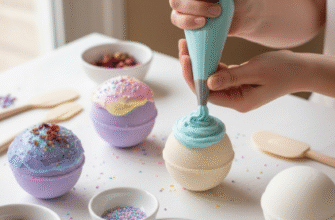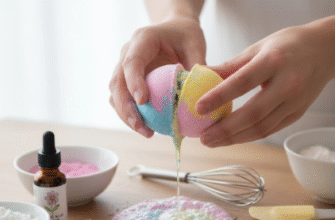Think about everything your hands go through in a single day. They type, they clean, they cook, they carry, they create. They’re constantly exposed to water, soaps, sanitisers, and the elements. It’s no wonder the skin on our hands can often feel dry, rough, or neglected compared to the rest of our body. While fancy hand creams are great, sometimes your hands need a little extra help to shed dullness and reveal softer, smoother skin underneath. That’s where a good hand scrub comes in, and the best part? You can easily whip up an incredibly effective one right in your own kitchen using simple, natural ingredients.
Making your own hand scrub is not only budget-friendly but also allows you complete control over what goes onto your skin. No mysterious chemicals, no harsh preservatives – just pure, simple goodness tailored to your preferences. Plus, the process itself can be a mini spa moment, a few minutes of self-care that leaves your hands feeling pampered and rejuvenated.
Why Exfoliate Your Hands?
Exfoliation is the process of removing dead skin cells from the surface of your skin. Just like the skin on your face and body, the skin on your hands accumulates these dead cells, which can lead to a rough texture, dull appearance, and can even prevent moisturisers from penetrating effectively. Regular, gentle exfoliation offers several benefits:
- Softer, Smoother Skin: This is the most immediate and noticeable benefit. Buffing away the dead cells reveals the fresh, newer skin underneath, which feels significantly softer and smoother to the touch.
- Brighter Appearance: Dead skin cells can scatter light unevenly, making skin look dull. Removing them helps restore a natural, healthier glow.
- Improved Moisturiser Absorption: With the barrier of dead cells gone, your hand creams and lotions can penetrate more deeply and work more effectively, leading to better hydration.
- Helps with Dry Patches: Gentle scrubbing can help loosen and lift away flaky, dry patches, especially around the knuckles and cuticles.
- Stimulates Circulation: The massaging action used when applying the scrub can help boost blood flow to the hands.
The Super Simple DIY Hand Scrub Base Recipe
Ready to get started? This basic recipe is incredibly versatile and uses ingredients you likely already have. Think of it as your foundation – you can customise it later!
Core Ingredients:
1. The Exfoliant: This provides the scrubbing power.
- Granulated Sugar (White or Brown): About 1/2 cup. Sugar is a great natural exfoliant. The granules are generally rounder than salt, making them a bit gentler. Brown sugar is typically softer than white sugar and contains molasses, adding a touch of extra moisture.
2. The Moisturising Oil: This binds the scrub together and nourishes the skin.
- Olive Oil or Coconut Oil: About 1/4 cup. Olive oil is rich in antioxidants and deeply moisturising. Coconut oil is known for its hydrating and potential antimicrobial properties (use fractionated coconut oil if you prefer it to stay liquid at cooler temperatures, or gently warm solid coconut oil before mixing).
Basic Instructions:
In a small bowl, combine the sugar and the oil. Stir them together thoroughly. You’re looking for a consistency that’s scoopable but not overly runny – think wet sand. If it seems too dry, add a tiny bit more oil. If it seems too oily, add a little more sugar. That’s it! Your basic scrub is ready.
Diving Deeper: Choosing Your Ingredients
While the sugar and oil base works wonders, understanding different ingredient options allows you to tailor the scrub perfectly to your needs and preferences.
Exploring Exfoliants:
- Sugar (White/Brown): As mentioned, a fantastic all-rounder. Gentle enough for most skin types. Brown sugar offers slightly more moisture.
- Fine Sea Salt: Provides a more vigorous scrub than sugar due to its sharper crystal structure. It also has mineral benefits. Best for tougher skin or occasional deeper exfoliation, but be cautious if you have sensitive skin or tiny cuts (it will sting!). Do not use coarse salt, as it can be too abrasive.
- Coffee Grounds (Used & Dried): A wonderful, invigorating option. Coffee grounds are a moderate exfoliant, and the caffeine is believed to temporarily perk up the skin’s appearance. Plus, the smell is amazing! Make sure the grounds are dried out after brewing.
- Fine Oatmeal: For a super gentle, soothing exfoliation, especially good for sensitive or irritated skin. You can use rolled oats pulsed briefly in a blender to make them finer. Oatmeal contains compounds that can calm the skin.
Exploring Moisturising Oils:
- Olive Oil (Extra Virgin): A classic choice, readily available, and packed with vitamins and antioxidants. Very hydrating.
- Coconut Oil: Excellent moisturiser, smells lovely (if you like coconut). Can be solid at room temperature, so may need gentle warming. Has some natural antibacterial properties.
- Sweet Almond Oil: Lighter than olive or coconut oil, absorbs relatively quickly. Rich in Vitamin E, great for nourishing nails and cuticles too.
- Jojoba Oil: Structurally very similar to our skin’s natural sebum, making it easily absorbed and less likely to feel greasy. Suitable for most skin types.
- Grapeseed Oil: A very light, easily absorbed oil. Good choice if you dislike any feeling of residue.
- Avocado Oil: A richer, heavier oil packed with nutrients. Excellent for very dry or mature skin.
Optional Add-ins for Extra Pampering:
This is where you can get creative! Add just a little bit – a few drops or a teaspoon – to enhance your scrub.
- Essential Oils: Add 5-10 drops for fragrance and potential therapeutic benefits. Popular choices include:
- Lavender: Calming and soothing.
- Lemon or Orange: Brightening and refreshing (use with caution if sun-sensitive).
- Peppermint: Cooling and invigorating.
- Tea Tree: Known for antibacterial properties (use sparingly).
- Chamomile: Gentle and calming for sensitive skin.
- Honey (Raw or Manuka if possible): A natural humectant, meaning it draws moisture to the skin. Also has antibacterial and soothing properties. Just a teaspoon can make the scrub feel more luxurious. It will make the scrub stickier, so adjust oil if needed.
- Vitamin E Oil: A potent antioxidant that helps nourish and protect the skin. Pierce a capsule and squeeze the oil in, or use liquid Vitamin E.
- Citrus Zest (Lemon, Orange, Grapefruit): Adds a lovely fresh scent and visual appeal. Make sure to zest only the coloured part, not the white pith, which can be bitter. Use fresh zest promptly.
- Vanilla Extract: For a warm, comforting aroma.
Step-by-Step: Making and Storing Your Scrub
Let’s refine the process slightly, incorporating potential add-ins.
1. Choose Your Base: Select your preferred exfoliant (sugar, salt, coffee, oatmeal) and your moisturising oil.
2. Measure: Start with roughly a 2:1 ratio of exfoliant to oil (e.g., 1/2 cup exfoliant, 1/4 cup oil). Pour the exfoliant into a clean, dry bowl.
3. Add Oil Gradually: Pour the oil over the exfoliant. If using solid coconut oil, melt it gently first (don’t make it hot, just liquid). Stir well to combine.
4. Incorporate Add-ins (Optional): If using essential oils, honey, Vitamin E, or zest, add them now and stir thoroughly to ensure they are evenly distributed.
5. Check Consistency: Adjust as needed. Too dry? Add a teaspoon more oil. Too wet? Add a tablespoon more exfoliant. Aim for that scoopable, damp-sand texture.
6. Transfer to Storage: Spoon your finished scrub into a clean, airtight container. A small glass jar with a tight-fitting lid works perfectly. This prevents moisture from getting in and keeps the scrub fresh.
7. Label (Optional but Recommended): It’s helpful to label the jar with the ingredients and the date you made it, especially if you make different variations.
How to Use Your Homemade Hand Scrub Effectively
Using the scrub correctly ensures you get the maximum benefits without irritating your skin.
1. Start with Damp Hands: Wet your hands with warm water. Don’t dry them completely; leave them damp.
2. Scoop a Small Amount: Take about a teaspoon or two of the scrub into the palm of one hand.
3. Massage Gently: Rub your palms together, then gently massage the scrub all over your hands using circular motions. Pay extra attention to areas that tend to get rough, like your knuckles, the backs of your hands, and around your cuticles. Be gentle – the exfoliant does the work, you don’t need excessive pressure.
4. Enjoy the Moment: Continue massaging for about 30-60 seconds. Breathe in the aroma if you’ve added essential oils!
5. Rinse Thoroughly: Rinse your hands well under warm running water until all traces of the scrub are gone. Your hands might feel slightly oily from the nourishing oils, which is perfectly fine.
6. Pat Dry: Gently pat your hands dry with a clean towel. Avoid rubbing vigorously, as the skin is freshly exfoliated.
7. Moisturise Immediately: This is a crucial step! Apply your favourite hand cream or lotion while your skin is still slightly receptive after rinsing. This locks in the moisture and the benefits of the scrub.
Important Considerations Before You Scrub: Always perform a patch test on a small area of your inner wrist before using a new scrub formulation, especially if you have sensitive skin or are using essential oils. Wait 24 hours to check for any reaction. Avoid using any hand scrub on broken, irritated, or sunburnt skin. Listen to your skin – if it feels overly sensitive or irritated during use, rinse off immediately.
How Often Should You Exfoliate Your Hands?
Moderation is key. Over-exfoliating can strip the skin’s natural barrier and cause irritation. For most people, using a hand scrub 1 to 3 times per week is sufficient to maintain soft, smooth hands. If your hands are particularly dry or sensitive, start with once a week and see how your skin responds. Pay attention to how your hands feel – they will tell you if you’re overdoing it.
Fun Customisation Ideas
Get creative and mix up scents and textures!
Invigorating Morning Citrus Scrub:
- Base: White Sugar
- Oil: Grapeseed Oil or Sweet Almond Oil
- Add-ins: 5 drops Lemon essential oil, 3 drops Orange essential oil, 1 tsp fresh Lemon or Orange zest.
Calming Bedtime Lavender Scrub:
- Base: Fine Oatmeal (pulsed) mixed with Brown Sugar (half/half)
- Oil: Jojoba Oil or Sweet Almond Oil
- Add-ins: 7-10 drops Lavender essential oil, optional 1 tsp dried lavender buds (use caution with plumbing if adding buds).
Coffee Lover’s Wake-Up Scrub:
- Base: Used Coffee Grounds (dried)
- Oil: Coconut Oil (warmed)
- Add-ins: 1/2 tsp Vanilla Extract, optional 1/4 tsp cinnamon (can be stimulating, patch test!).
Ultra-Soothing Honey Oat Scrub:
- Base: Fine Oatmeal
- Oil: Avocado Oil or Olive Oil
- Add-ins: 1-2 tsp Raw Honey, 3 drops Chamomile essential oil (optional).
The Rewarding Results
Taking just a few minutes once or twice a week to treat your hands to a DIY scrub is a simple act of self-care with noticeable rewards. You’re not just washing your hands; you’re actively improving their texture, appearance, and health. Say goodbye to rough patches and dullness, and hello to hands that feel wonderfully soft, look noticeably brighter, and are better prepared to soak up your favourite moisturisers. It’s an easy, affordable, and natural way to give your hardworking hands the appreciation they deserve.
So raid your pantry, pick your favourite oil and exfoliant, and perhaps a scent that makes you happy. Mix up your personalised batch of hand-smoothing magic and get ready to feel the difference. Your hands will thank you!








